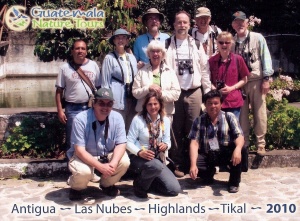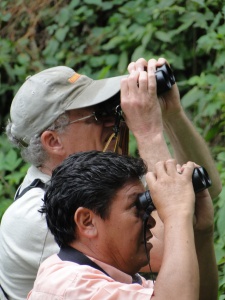
I’m re-posting this on the 14th anniversary of the trip.
Eight friends traveled for 12 days in Guatemala at the end of February and beginning of March, 2010. Our trip was organized and lead by Dr David Mehlman, ornithologist & friend, with the help of Bitty Ramirez-Portilla and Miguel Marin, among other local guides and hosts.
Our primary motivation was, ostensibly, birding plus visiting some Mayan ruins. Most of this group had traveled together on one or two trips to Ecuador. This was my first trip; I was working on earlier occasions. (This was also my first time on an airplane since January 2002 and my first time out of the country — other than driving to Canada — since 1991.)
[See the birds from this trip.]
Albuquerque to Houston to Guatemala City to Antigua
The first day of our trip ended after miles of travel in a former capital of the Spanish empire, Antigua, an old city of narrow cobblestone streets. We stayed two nights at Las Farolas (the lanterns), a lovely hotel with an interior courtyard that contained a tidy jungle dense with diverse plants and trees that towered over the building. It was hard to believe we were in the middle of a city when looking out from the balcony at the lushness and relative stillness.
Antigua is home to many language schools, so it provides an interesting mix of locals and visitors. Outside of Guatemala City, this was our most urban stop, with some shopping and multiple trips to ATMs for Quetzales, the Guatemalan currency (roughly eight to a dollar) named after a glorious, indigenous bird we hoped to see — and did, later!
About 4am of our first night in country, we experienced an earthquake. I thought I had accidentally activated a vibrating bed function. That morning we drove out to Finca (farm) el Pilar for breakfast with a vista of several volcanoes, one of which smoked a bit. We took our first jungle stroll birding.
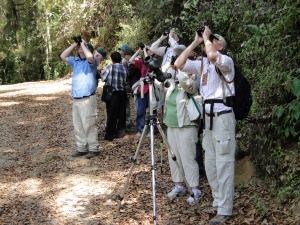 If you’ve never traveled with birders, the process consists of walking a few steps, freezing and pointing into a thicket, whispers and gestures, all binoculars pointed in the same direction. After a pause that sometimes lasts a half hour, everyone looks at pictures in a book of what we may have just seen. Sometimes, there are smiles and high fives. Repeat. Repeat. Repeat. It can be more fun than I make it seem; it can be just as interminable as I make it seem. Bird-walking requires a very different kind of stamina from other hiking.
If you’ve never traveled with birders, the process consists of walking a few steps, freezing and pointing into a thicket, whispers and gestures, all binoculars pointed in the same direction. After a pause that sometimes lasts a half hour, everyone looks at pictures in a book of what we may have just seen. Sometimes, there are smiles and high fives. Repeat. Repeat. Repeat. It can be more fun than I make it seem; it can be just as interminable as I make it seem. Bird-walking requires a very different kind of stamina from other hiking.
I do not mean to hurt the feelings of my birding friends. I really enjoyed the trip and saw many spectacular birds. At times, the excitement over this drab little bird or that was lost on me, but that’s my problem, not theirs.
In town, Mer spotted a purse in a market, but didn’t get it immediately, setting the stage for more than one return visit to the mercado. She also complimented a vendor on the street en español for her lovely blouse, to which came the reply, “make an offer” and some laughter over buying the clothes off of someone’s back. (At least, it seemed like a joke.)
It was also in Antigua that we had our first Gallo (rooster) of the trip. Gallo seems to be *the* beer of Central America. It also seems it is unavailable in the USA because of conflicts with Gallo wine. “Gallo y pollo” — beer and chicken — was our mainstay. (Moza was a good cerveza oscura.)
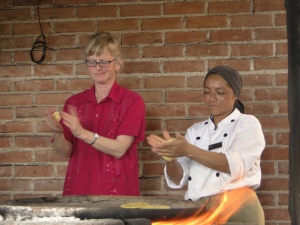 It was also here that Merri had her first lesson in making corn tortillas by hand at Finca Filadelfia (Spanish for “dangerously slick tileâ€).
It was also here that Merri had her first lesson in making corn tortillas by hand at Finca Filadelfia (Spanish for “dangerously slick tileâ€).
Finca Las Nubes
After Antigua, we rode by van to Finca las Nubes (the clouds), which is a working coffee plantation also engaged in eco-tourism. Las Nubes is located along the side of a volcano.
At las Nubes, our host was Mario Castillo, who clearly relishes hosting. We had lovely, brightly painted quarters with great birding on the patio, even from a hammock. Twice, we rose before dawn to ride in open land rovers (one from 1959 or so) up the side of a volcano, deeper into the jungle. We saw lots of great birds and vegetation.
Birders recognize many bird calls. Our guides were the first I had encountered who were also adept at making a variety of calls (beyond the common “pish”).
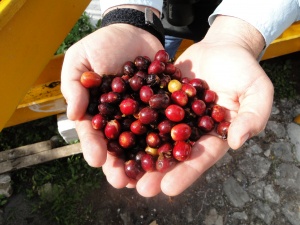 Back at the ranch, Mario led us on a tour of the processing plant for the coffee. It was fascinating. For the record, the very worst coffee beans go for instant coffee. The best go to Starbucks or the Japanese. Mario hopes the Chinese become coffee fiends. Naturally, we enjoyed the best cups of coffee at las Nubes; we brought some home with us, as well.
Back at the ranch, Mario led us on a tour of the processing plant for the coffee. It was fascinating. For the record, the very worst coffee beans go for instant coffee. The best go to Starbucks or the Japanese. Mario hopes the Chinese become coffee fiends. Naturally, we enjoyed the best cups of coffee at las Nubes; we brought some home with us, as well.
One morning, we stood for an hour on a deck that jutted over a jungle ravine, waiting and hoping for the resplendent quetzal. As the sun topped a ridge, a female quetzal shot almost straight up, perhaps a quarter mile from our location.
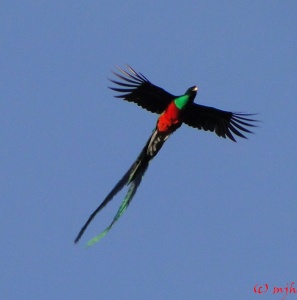
Only a moment later, the unbelievably bright male rose straight up, closer to us, flying up until the sun struck him, turning his green and red into neon. The male’s tail is absurdly long. I was lucky enough to capture the picture of a lifetime. We really did cheer and high-five this great experience.
In no way disparaging of the rest of the trip, las Nubes may have provided the best combination of birding, hanging out, eating and drinking. It was a hard act to top.
Finca Los Tarrales
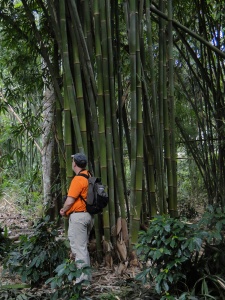 From las Nubes, we rode by van to Finca los Tarrales (bamboo), another farm taking up ecotourism. Afterwards, I think the birders regarded this as a better birding experience than las Nubes (leaving aside the resplendent quetzal). I enjoyed the terrain of las Nubes more, but the huge bamboo thickets of los Tarrales were quite amazing. Highlights for me included an Amazon Kingfisher next to a shadowy spring beneath dense bamboo and a trogon.
From las Nubes, we rode by van to Finca los Tarrales (bamboo), another farm taking up ecotourism. Afterwards, I think the birders regarded this as a better birding experience than las Nubes (leaving aside the resplendent quetzal). I enjoyed the terrain of las Nubes more, but the huge bamboo thickets of los Tarrales were quite amazing. Highlights for me included an Amazon Kingfisher next to a shadowy spring beneath dense bamboo and a trogon.
We had a little more autonomy here and broke up into smaller groups a few times.
This was the only place it rained during our stay. The sky opened up just before happy hour. During the night, it rained at least once.
Unfortunately, it was also here that Mer’s cough turned for the worse. She had had a cough for most of a month at that point; my version of this illness was bad enough but was getting better by then. Mer was getting worse. Pobrecita cariña!
Lago de Atitlan to Panajachel to Molino Hevetia
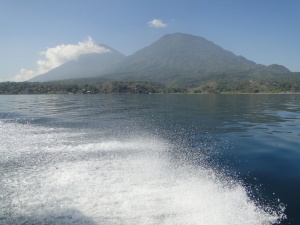
We left los Tarrales and rode into a volcanic caldera that contains Lake Atitlan. We crossed the lake by powerboat in a journey that lasted at least half an hour. It was great fun. We arrived in Panajachel, a touristy lakeside town. The group splintered to wander the streets and markets for an hour and more. Here, as in Antigua, we were frequently approached by street vendors, a few of whom seemed tragically desperate to sell something at almost any price.
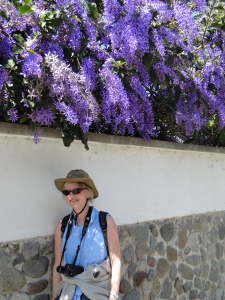 Mer and I escaped the sun and — briefly — the vendors by resting in an empty stall. A few vendors approached now and then, though most didn’t linger as Mer coughed and sniffed. Eventually, one found her way through our defenses. This was Candelaria, dressed in Mayan traditional dress, who offered me a vibrant orange short-sleeve shirt. My hesitation gave me away. “Tengo mas colores” she said, pulling at least a dozen more shirts from the bundle on her head. I liked the blue and the orange. The combination of a foreign currency and a foreign language made me unsure of the bargain, but we struck a deal. I passed up on the belt. Marked now as buyers, we were swamped by vendors, pressing in on us. It would have been more intimidating were they taller.
Mer and I escaped the sun and — briefly — the vendors by resting in an empty stall. A few vendors approached now and then, though most didn’t linger as Mer coughed and sniffed. Eventually, one found her way through our defenses. This was Candelaria, dressed in Mayan traditional dress, who offered me a vibrant orange short-sleeve shirt. My hesitation gave me away. “Tengo mas colores” she said, pulling at least a dozen more shirts from the bundle on her head. I liked the blue and the orange. The combination of a foreign currency and a foreign language made me unsure of the bargain, but we struck a deal. I passed up on the belt. Marked now as buyers, we were swamped by vendors, pressing in on us. It would have been more intimidating were they taller.
After a nice restaurant lunch, we vanned (why not) out into the countryside to Molino (mill) Helvetia. On the way, Miguel asked if we wanted chicken or beef for dinner. As one, we shouted beef. A week of chicken twice a day had been enough for us. (We also had fruit and two types of black beans with every single meal and tortillas with most.)
The house we occupied was grand by any country’s standard. It was a house with real personality and elegance. In hindsight, we might have been best off bringing groceries and beer and making it clear we would enjoy taking care of ourselves for a couple of days. Still, we were well-tended to yet found the independence to make our own coffee and do our own laundry (at least, Mer did). We sat together in the living room, warmed more by rum than the nice-looking fire. Mer laid under blankets looking like death.
Of all the trails we hiked, the trail out of the Molino seemed the most comfortable to me. It was mostly level and along a stream with some clear space on either side — an open slot through the jungle.
We made a daytrip out of Molino to the Mayan city of Iximche, our first ruins. Iximche was a great introduction to the architecture and more of the Maya, although it just hinted at what we would see in Tikal. Sunday at Iximche saw dozens of Guatemalan visitors, but we seemed to be the only foreigners.
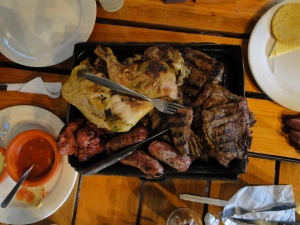 But first, before Iximche, we stopped at a roadside eatery packed with locals. We were served two hibachi-style grills piled with various meats. (This after a steak dinner the night before. Be careful what you wish for.) We barely finished one of the two piles. Although it is not certain, this may have been our downfall. Certainly, several of us came down with intestinal issues over the next two days.
But first, before Iximche, we stopped at a roadside eatery packed with locals. We were served two hibachi-style grills piled with various meats. (This after a steak dinner the night before. Be careful what you wish for.) We barely finished one of the two piles. Although it is not certain, this may have been our downfall. Certainly, several of us came down with intestinal issues over the next two days.
After Iximche, we returned to Molino Helvetia and the most gourmet of all the meals we had in Guatemala. The food, including the sumptuous chocolate dessert, was so great, we asked the chef to come out for applause.
Tikal
After two days, we left Molino Helvetia. On the road to Guatemala City, we stopped for breakfast at Rincon Suizo. (“Swiss Corner” which, along with Cabaña Suiza and Molino Helvetia, suggests an unexpected impact of the Swiss on Guatemala.) I’m not sure anyone relished breakfast that morning. Our jefe, David, was laid flat in the bus. Mer was, too, albeit for different reasons. Most of the rest of us were less than perky. Oddly, this spot along the highway is also know for the pink-headed warbler, so we did some birding after breakfast, with some success.
In Guatemala City, we had lunch at a beautiful spot in the mercado, joined by Bitty and her husband, Renato Fernández Ravelo, an accomplished bird photographer. David and Mer went with Bitty to the hospital, while the rest of us wandered the stores. At the airport, David rejoined us and Mer said goodbye. As we went on, she went with Bitty to Antigua (and that purse she wanted). The next day, she flew home.
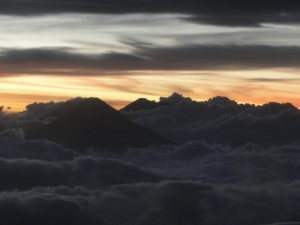 The rest of the group boarded Taca Airlines to fly to Flores, near Tikal, in the north and the lowlands. The sun set blood red as we departed. Through the twilight, a volcano peaked above roiling clouds, an island in a rough sea. As we crossed the Flores tarmac an hour later, the crone moon rose as bloody as sunset and nighthawks strafed the landing field. It was magical, until we piled into a small van for a long drive through the darkness to Tikal. En route, we stopped at the equivalent of a 7-11 for junk food which served as dinner. Every few kilometers, the van slowed nearly to a stop to drive over a speed bump that served to mark another collection of dwellings around which people enjoyed the evening.
The rest of the group boarded Taca Airlines to fly to Flores, near Tikal, in the north and the lowlands. The sun set blood red as we departed. Through the twilight, a volcano peaked above roiling clouds, an island in a rough sea. As we crossed the Flores tarmac an hour later, the crone moon rose as bloody as sunset and nighthawks strafed the landing field. It was magical, until we piled into a small van for a long drive through the darkness to Tikal. En route, we stopped at the equivalent of a 7-11 for junk food which served as dinner. Every few kilometers, the van slowed nearly to a stop to drive over a speed bump that served to mark another collection of dwellings around which people enjoyed the evening.
This was our longest day since our arrival. At the Jungle Lodge, we checked in and staggered to our bungalows to crash for the night.
The next morning may have been the first the serious birders weren’t out to meet Miguel at 6am. After a very slow-to-arrive breakfast, we walked toward Tikal, first along a wide dirt road then up narrow, winding paths.
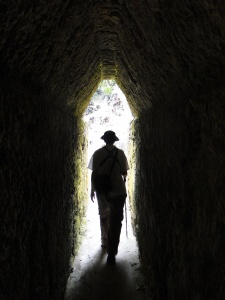
As you may know, I’ve been fascinated with the architectural remains and locales of the ancients of the southwest ever since my arrival here and my first visit to Chaco Canyon. I expect always to love Chaco. But nothing really prepared me for the massive scale of Tikal, where the land itself was reshaped repeatedly over centuries and massive structures were built over or around previous structures time and time again. Tikal is huge. A couple of temples may be made of more stone than all of Chaco (which still remains a stunning achievement).
Several of the temples in Tikal have wooden staircases or ladders enabling one to climb to the top without over-using the original stone steps. The views are spectacular, particularly when you see other temples poking up out of the dense jungle.
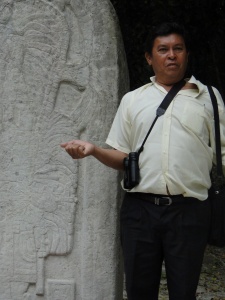 Miguel was our guide throughout the trip. His father was Mexican and his mother Maya, as is his wife. Not only is Miguel a great birder, but he has over 20 years experience in archaeology in and around Tikal, which is near his home. Miguel provided us with more than data, with a deeper connection to Guatemala. He stood before a stella replica that he and a friend had carved 20 years earlier. In Tikal, he led us around more quickly than he might have wished.
Miguel was our guide throughout the trip. His father was Mexican and his mother Maya, as is his wife. Not only is Miguel a great birder, but he has over 20 years experience in archaeology in and around Tikal, which is near his home. Miguel provided us with more than data, with a deeper connection to Guatemala. He stood before a stella replica that he and a friend had carved 20 years earlier. In Tikal, he led us around more quickly than he might have wished.
We returned to a late lunch from hours of walking around just part of Tikal. After lunch, I would have happily napped, but I felt I had to seize this opportunity, so I hurried back up the trail to the Gran Plaza shortly before closing. As I went up the trail alone, I was walking toward the roar of howler monkeys, which made me think twice. These trails have limited signs and most visitors travel with a guide, so I was concerned about losing my way. Still, I made it there with time to spare, to see a few things I missed the first time. Amazing.
Petexbatún Lagoon and Aguateca
Just as we had arrived at Tikal in darkness, so, too, did we leave, this time before dawn or coffee. After daybreak, we arrived at Casa de Don David for breakfast.
Then we rode to a river bank where we boarded a long narrow boat with a thatched roof. Our captain piloted us across the river into a side stream. At times, the stream was very narrow and shallow; it twisted many times. Frequently, we passed people in boats or on shore washing clothes or fishing.
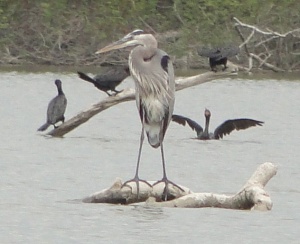 Everywhere, there were countless birds. I saw a thousand times more cormorants than I’ve ever seen, along with hundreds of herons (three species), egrets (two or three species), and kingfishers (three or more species).
Everywhere, there were countless birds. I saw a thousand times more cormorants than I’ve ever seen, along with hundreds of herons (three species), egrets (two or three species), and kingfishers (three or more species).
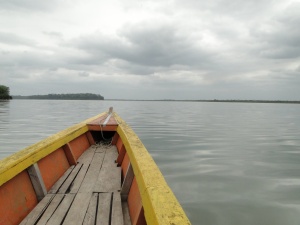 Eventually, the narrow stream opened up into the Petexbatún Lagoon, which looked like a large lake.
Eventually, the narrow stream opened up into the Petexbatún Lagoon, which looked like a large lake.
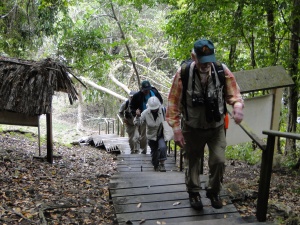 We crossed the lake and entered another narrow stream and came ashore downhill from Aguateca, where the Maya moved during a period in which they vacated Tikal (to which they returned after a few hundred years, I think). Clearly, Aguateca is very remote. We picked our way through mud and muck to reach the first of two long wooden stairways up to the level of the ruins.
We crossed the lake and entered another narrow stream and came ashore downhill from Aguateca, where the Maya moved during a period in which they vacated Tikal (to which they returned after a few hundred years, I think). Clearly, Aguateca is very remote. We picked our way through mud and muck to reach the first of two long wooden stairways up to the level of the ruins.
Unfortunately, time was precious this last full day of the trip and the boat trip lent an uncertainty in timing our arrival at the Flores airport for our only chance to return to Guatemala City that day. So, we didn’t have much time at Aguateca, but enjoyed the time we had. After lunch, we returned to our boat and reversed our course through more spectacular birding. For me, this was the best of the trip (always putting the resplendent quetzal in its own category).
Back to the van and the dash to the airport. At the airport, we said farewell to Miguel, who had a day or two off at home before the Dutch and German tourists arrived. With time to kill at the airport, we sat outside a snack shop, drinking beer and celebrating the trip.
It was here or soon after that I lost Mer’s binoculars. I don’t know if I left them hanging on a chair there or if they ended up under a seat on the airplane. Either way, I lost them.
Back at the Guatemala City airport well after dark, Bitty met us and took us to a hotel far too elegant for me, especially in my shorts and mucky shoes. I bid farewell to those who would leave early the next day and retired to my room.
Our last morning in Guatemala, after the East Coast contingent had left, we went to Bitty’s house for breakfast and one last bird stroll. I remember seeing a flock of cedar waxwings turn as one into a bush and vanish completely. On the way to the airport, we met Mario for a few pounds of las Nubes coffee (the only coffee Merri has ever enjoyed). We did some last minute shopping in airport gift shops and began the soul-crushing process of Security in an insecure (and unsecurable) era.
On the plane, Don David turned to me and said, “tell me more about what you’d like to see in Peru.” Already planning the next trip. Take a break, jefe, you earned it.
Hours later, I sat jabbering in the Frontier with mi corazon. Nothing like sweethearts and green chile to welcome you home.
[See the birds from this trip.]
blog visitors 26349 | views 27576

